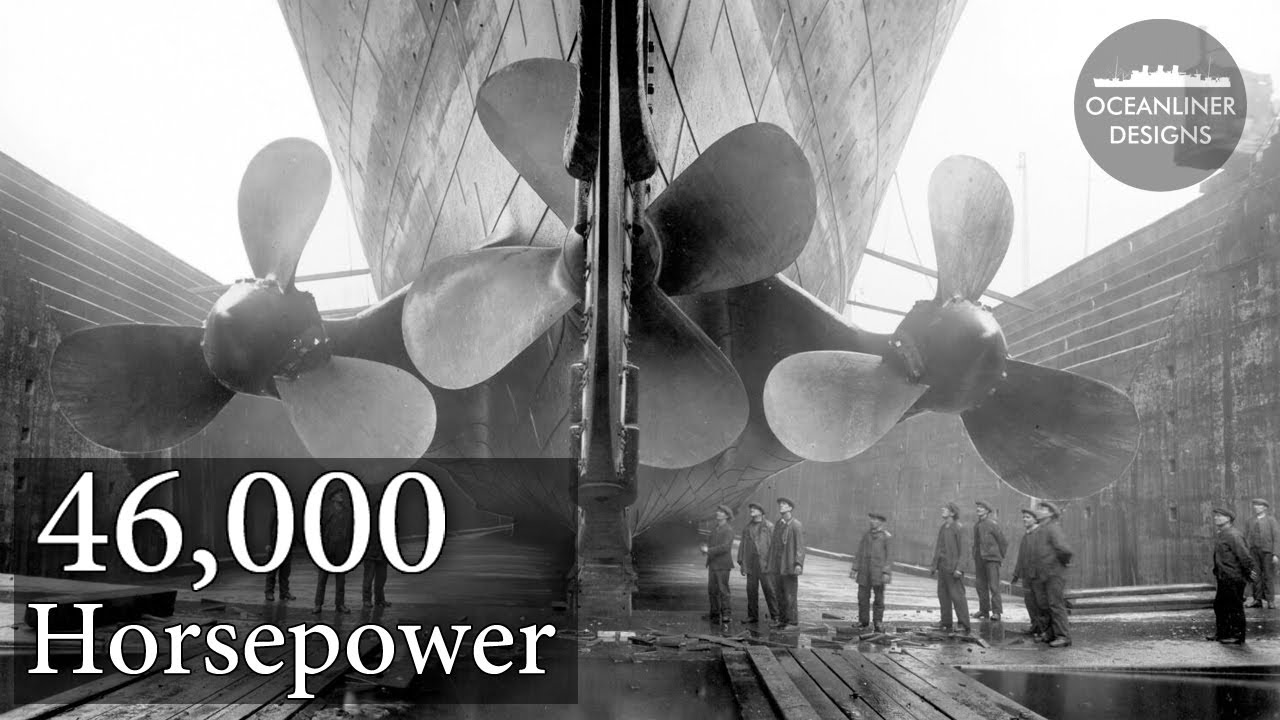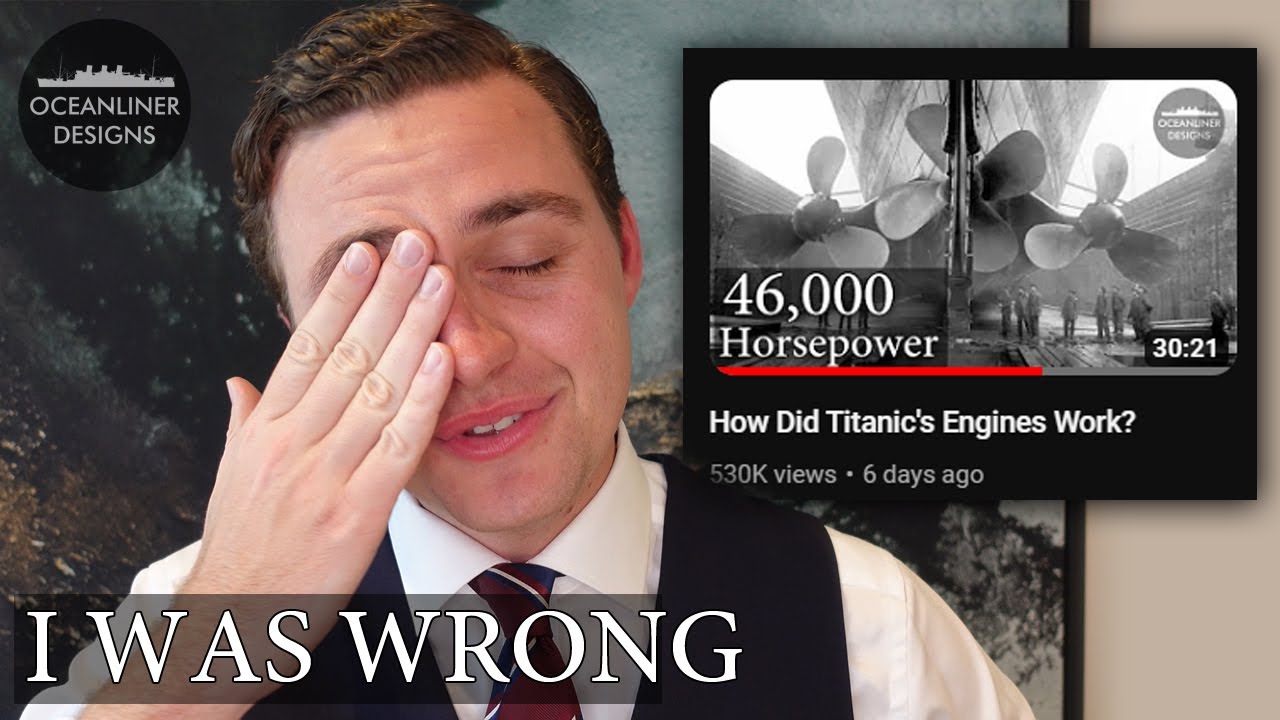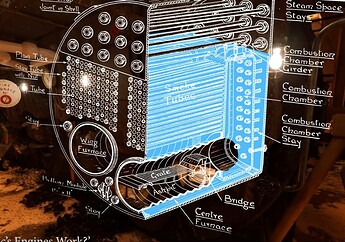I had heard about the Titanic’s two main reciprocating triple-expansion steam engines (total power 22 megawatts), but didn’t know that steam leaving the main engines then passed through a 12 megawatt steam turbine which drove the centre propeller. This hybrid propulsion system allowed the ship to cruise at 39 km/hour (maximum speed 43 km/hour) which, while slower than the 44 km/hour cruise of Cunard’s all-turbine ships Lusitania and Mauretania, burned half the amount of coal per hour while at cruise speed and avoided the vibration at high speeds that plagued the turbine-only ships.
Anyone else bothered by the centre propeller turning backwards in all those animations?
I am surprised by some of the technical assertions… for example, it “just hurts” to think about putting seawater into the boilers (then again I aint no maritime engineer type, I don’t know how much makeup water would be needed on a voyage)
This was an error in the original video. The creator has posted an errata video which corrects this and other goofs. The water in the propulsion loop is discussed starting at the 2:50 mark.
In fact, the steam generators and engines worked on fresh water. Initially, they used feed water loaded in port. Steam exiting the turbine passed through a condenser which turned it back into water that was recycled into the boilers. En route, losses due to evaporation, leakage, or contamination (for example, from lubricants) were replenished by distilled water created by a desalination plant that employed “evaporators” to boil seawater which was condensed to produce up to 60 tons of distilled water per day. This is described starting at 6:30 in the video.
Other errors in the video were the description of the steam that drove the engines as “superheated”, when in fact they operated on saturated steam at 215 psi leaving the boilers.
The statement that steam exiting the triple-expansion engines was at less than atmospheric pressure was not an error. The turbine created a partial vacuum which allowed the last stage of the reciprocating engine to extract more energy from the steam before discharging into the turbine.
I don’t know about the rotation direction of the centre propeller. The nuclear powered icebreaker on which I travelled to the North Pole in 2008 had three electrically driven propellers, two of which spun in one direction and one in the other, which was described as intended to “minimise torque effects”. The icebreaker’s propellers can be all be reversed and used for differential thrust in maneuvering. Titanic’s centre propeller, driven directly by the turbine, could not be reversed, so only the two outer propellers, driven by the reversible reciprocating engines, could be used for reverse thrust. There was no clutch for disengaging the turbine from the propeller—for maneuvering or going astern, steam would be diverted around the turbine directly into the condenser by a “changeover valve” between the reciprocating engines and the turbine.
Here is a Web page with extensive details on Titanic’s power plant, “Titanic’s Prime Mover – An Examination of Propulsion and Power”.
It seems to me that counter-rotation of the central propeller would dramatically reduce turbulence beween the propellers.
I wonder how the total power output compares to that of modern giant cruise ships powered by multiple, directional power pods.
Rotation direction - I meant that the propeller was turning in a direction such that the propeller pushed the water forwards rather than backwards. The outer propellers (counter-rotating w.r.t. each other) were pushing water backwards.
Counter-rotating propellers are smart, the problem with three is that it is an odd number so you can’t help but having two rotate in a direction opposite to one.
civilwestman writes:
I wonder how the total power output compares to that of modern giant cruise ships powered by multiple, directional power pods.
Well, if Titanic was a 23-knot ship, and if modern cruise ships go similar speeds (a zeroth order search says “cruise ships go 20 knots”), and the hulls are of comparable size (tonnage, length)… it pretty much has to be the same ballpark, i.e. a few 10s of thousands of HP or 10s of MW). More than 10MW, well less than 100MW.
It is interesting to think how this compares to other large scale power plants… my local hydroelectric dam has six 100MW turbines, the local CANDU is 660MW (did you ever notice there seems to be a sweet spot in stationary nuclear power reactors of 1000MW +/- 50%?), the combined cycle gas turbine peaking plant in the local power system is several hundred MW (IIRC an industrial stationary version of a 777-class engine)
Huge ship engines (reciprocating diesels, thermal efficiency over 50%, 100-ish RPM) nearly but don’t quite make it to 100MW.
In my original post I was going to gripe about not seeing how the boiler cutaway would produce superheated steam, but that seemed perhaps picky and presumptuous, especially for my first post, so I held my tongue, but hey since I’m on a roll and griping now… ![]()
Anyone else bothered by the centre propeller turning backwards in all those animations?
Yes! I thought it was just me. : -)


